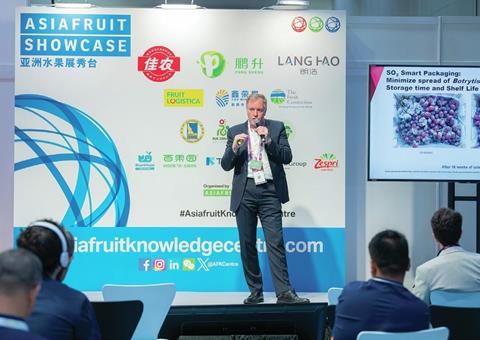Audiences at this year’s Asiafruit Showcase stage received insights from AgroFresh, Rijk Zwaan, Sekoya Fruit, Guangzhou Jiangnan Fruit and Vegetable Wholesale Market, Shanghai Huizhan, Copeland and Shanghai Jiaogeini Industrial Development

The importance of utilising data in business decisions was a common theme of the Asiafruit Showcase presentations at this year’s Asia Fruit Logistica. From its application in managing food waste to product development and consumer understanding, accurate and consistent data supports overall business success.
To combat food waste across the supply chain, AgroFresh has created a suite of products and services including innovative packaging with SO2 pads and ethylene management.
“Just looking at apples with SmartFresh (one of AgroFresh’s ethylene management lines), we have saved close to 260,000 tonnes of waste, reduced the CO2 equivalent of about 2m cars on the road per year and saved about two and a half tonnes of water,” Duncan Aust said.
To keep track and identify areas of improvement for its clients, the company has also introduced a cloud-based platform, FreshCloud, to collate data points across client supply chains to support ongoing sustainability efforts.
Copeland’s Gerd Uitdewilligen also spoke about the importance of data collection throughout the cold chain.
“Food changes hands a lot of times,” he said. “The chances of arriving at the right temperature are relatively small if you don’t inspect your cold chain.”
Through its in-transit sensors, Copeland provides its clients with real-time temperature data so that they can address concerns immediately.
“The data difference is increased food safety and brand protection first and foremost,” Uitdewilligen said. “You can ensure that the customer has the best experience, and we as an industry continue to drive down food waste and end up with the best tasting fruit.”
For Rijk Zwaan, consumer data has been an important factor in introducing its sweet pepper lines throughout Asia, where consumers have limited experience with the snack category.
Through market research, Rijk Zwaan found that Asian consumers associate all red peppers with hot peppers but when introduced alongside other colours this association reduced from 94 per cent to 64 per cent.
These findings influenced how Sweet Palermo was packaged in Asia, often appearing in three-colour packs.
“In Europe, 95 per cent of the Sweet Palermo peppers we sell are red. In Asia, almost everything is a mix,” shared Heleen van Rijn-Wassenaar.
Sekoya is also utilising consumer data to help move blueberries away from a commodity market.
“The risk of blueberries today is that we become a commodity like bananas. You eat a banana, it is a banana, and the banana price goes down year after year,” shared Hans Liekens.
Comparatively, products like potatoes, which were once seen as a commodity, have been able to transform into clear segmented lines.
“For us, it’s the same opportunity,” Liekens said. “We believe that to-go, kids, breakfast, salad and snacking are consumer moments which we can define and nail down.”
Asiafruit Showcase also hosted two Chinese-language sessions. Lai Yong jin of Guangzhou Jiangnan Fruit and Vegetable Wholesale Market and Marie Wong from Shanghai Huizhan shared insights on the conventional distribution channel and how it is adapting to an evolving supply chain landscape. The Showcase audience also heard from Jiao Jie of Shanghai Jiaogeini Industrial Development on the future trends in China’s premium fruit market and the prospects for high-quality fruits.



